Saturday, June 06 2015
Why buy only a metal detector when now you also get FREE accessories?! For a limited time, Garrett is offering the ACE The Garrett ACE 250 metal detector (#1139070) will be shipped with 3 FREE ACCESSORIES: Garrett TreasureSound headphones with volume control (#1612500), and a 6" x 9" searchcoil cover (#1605700) and the ACE Environmental Cover-Up (#1619900). All of this for just $212.45! You SAVE $49.85 MSRP compared to purchasing the detector and three accessories individually. The ACE 250 is Highly Recommended for Coin Hunting, Competition Events, Dry Beach/Fresh Water Hunting. Recommended for Jewelry Hunting, Relic Hunting, Ghost Town Hunting. Key Features:
Search Modes (Discrimination Patterns): 5 plus electronic pinpointing
Download the owner's manual, purchase, or learn more about the Garrett ACE 250 here. The Garrett ACE 350 metal detector (#1140260) will be shipped with 3 FREE ACCESSORIES: a Garrett Camo Digger's Pouch (#1612900), an 8.5" x 11" searchcoil cover (#1606600) and the ACE Environmental Cover-Up (#1619900). All of this for just $297.45! You SAVE $41.85 MSRP compared to purchasing the detector and three accessories individually. The versatile ACE 350 includes the best features of the world-famous ACE 250 but adds a powerful new 8.5" x 11" DD searchcoil, enhanced iron discrimination, and a higher frequency. This machine is highly recommended for Coin Hunting, Jewelry Hunting, Relic Hunting, Competition Events, Dry Beach/Fresh Water Hunting. If you want to search homesites, parks, campgrounds, playgrounds, and beaches, the ACE 350 is ideal! Key Features
Search Modes (Discrimination Patterns): 5 plus electronic pinpointing
Download the owner's manual, purchase, or learn more about the Garrett ACE 350 here. No matter which you choose— the 250 or the 350 Discovery Pack— both detectors includes Garrett’s patented discrimination feature. This technology, found only on Garrett detectors, features two indicator scales that allow the user to see the detector’s discrimination setting (Lower Scale) as well as the analysis of each detected target (Upper Scale). Offer for FREE accessory discovery packs ends December 31, 2015. Happy Hunting! Monday, May 25 2015
First Texas Products, manufacturer of the Fisher, Bounty Hunter, and Teknetics brand metal detectors, is
For the Demo/Instructional category, make a new video using any First Texas Products machines and show how to set up your machine, adjust the settings and provide any great hints or tricks you've learned since you began using your detector. For the hunting category, make a new video showing your hunt, finds, and the good times you have while out in the field with First Texas Products metal detectors. Enter the contest by making your videos and posting them on the corresponding YouTube channel (see below for channels). For example, if you are making a Fisher Video, post your video on the Fisher YouTube channel. If you are making a Bounty Hunter video, post your video on the Bounty Hunter YouTube channel. RULES:
Please share this with everyone you know that owns any First Texas Products metal detectors. Good Luck and Happy Hunting! Saturday, May 09 2015
In July 1986, Life magazine described Nevada’s U.S. Highway 50 between Ely and Fernley as the “Loneliest Lead and silver ore was first discovered in Eureka during the fall of 1864 when a party of five prospectors traveling 70 mile from the silver camp of Austin to explore the area. Unlike most new mining strikes, not much excitement was caused by this find— not because the assays of the rock weren’t favorable, because they were, but because the smelting methods available at the time were not suited to treat the oxidized gold-silver-lead ores (those which are found above the water level) they had found. The ore was rich in iron and arsenic and occurred in a form that was hard for the miners to process economically. When smelters were perfected and constructed several years later, mining boomed. The 16 smelters around town certainly didn’t improve air quality, but perhaps it was the 100 saloons that helped the nearly 10,000 residents forget about the pollution! At about that same time, several rich ore bodies on Ruby Hill were discovered, and as a result, the Eureka mining district became quite prosperous. Because of the town's central location in the state, it became a railhead for the whole area, which kept Eureka alive even after production decreased. Most of the district’s production was made between 1870 and 1890. Although there have been large amounts of gold produced in the last 50 years, the recorded production up to 1964 was approximately 313,000 tons of lead, 7,000 tons of zinc, 1,000 tons of copper, 1.65 million ounces of gold, and 39 million ounces of silver. These production totals are probably understated since records prior to 1901 were incomplete. Since 1964, nearly 1.5 million ounc To get a sense of Eureka’s past, and see dozens of historic buildings and sites in downtown, pick up a self-guided walking tour map at the Sentinel Museum, then spend a couple of hours or all day stepping back in time. A few highlights include: Eureka Opera House, built 1879, has been fully restored and now serves as a convention center and auditorium. Elegant features such as a chandelier, curtain, wood floors and horseshoe balcony (one of only three horseshoe-shaped balconies in Nevada) have been preserved. Historic graffiti has been preserved back stage from the early days, and the tradition has been continued with signatures of the people who have performed at the Eureka Opera House since it was reopened.
The 1877 Jackson House next door to the Opera House has been beautifully restored and has nine Victorian bedrooms upstairs, and a bar and restaurant downstairs. The brick Eureka Sentinel Newspaper Building dates from 1879 and now houses a museum. This structure was used as the newspaper office and residence until 1960, and was made into a county historical museum in 1982. The downstairs press room, shown above, features all original equipment on which the Sentinel was printed in the boom days of Eureka. Old copies of the Sentinel are tacked on the walls. In the mining history room upstairs you will see tools from the early days of mining, as well as historic stock certificates, ledgers and personal miners items. Lifestyle artifacts from the early days of Eureka are there, too, including items from schools, homes, and businesses. IF YOU GO: 10 North Monroe Street (right behind the Courthouse) Eureka, Nevada Phone: 775-237-5010 November – April: Tuesday through Saturday 10 a.m. to 6 p.m. May – October: 7 days per week 10 a.m. to 6 p.m.
31 South Main Street, Eureka, NV 89316 Phone: 775-237-6006 Monday, April 27 2015
What is the best metal detector? This is probably the Number One question that everyone asks when How much do you know about metal detectors? Be honest because the answer also affects your budget. If you're just getting started and plan to go out just a few weekends a year, you may not want to shell out a lot of cash up front so a general all-purpose detector in the $200 range will suit your needs. If you have used a friend's detector a few times and are fairly serious about wanting to find gold and other buried treasures of your own, then buy a detector in the $700 range that is user-friendly. You will get a very good quality machine with plenty of bells and whistles, yet it won't require an advanced degree to actually use it. And you won't have to spend hours reading the owners' manual to understand it either. Before investing in a model that costs thousands of dollars, first be sure you love detecting and will use it often enough to justify the big price tag no matter what brand you decide on. Garrett and Fisher are two of the oldest manufacturers in the business.
What do you primarily hope to find? If you want to find gold, you'll need a detector especially made for that purpose. Gold detectors are not necessarily more expensive, but they are built with a higher sensitivity to detecting gold nuggets, and have better ground balancing and discrimination abilities. PI machines aren't so good for coin shooting in urban areas where you are likely to encounter iron trash, however, they are ideal for beaches or detecting in other highly mineralized soils, especially if you are looking for objects that are deeply buried. VLF detectors are more sensitive to finding the smallest bits of gold, but do not as easily cancel out ground mineralization.
Metal Detectorist Code of Ethics
Saturday, April 11 2015
Thirteen years ago, Park City, Utah was the place Olympic athletes and thousands of spectators visited to “go for the gold” during the 2002 Winter Games. More than 145 years ago, however, an even larger group of people rushed to Park City seeking a different precious metal— silver. The first mining claim was filed in December 1868, and for over a century, the abundant veins found in the Wasatch Mountains surrounding the small town produced about $400 million in silver. When the mining industry slowed down in the 1920s and 30s, Park City's winter sports ramped up. Good money continues to be made today— with snow and tourism. Silver mining, though, is the town’s legacy, and still very much honored around town. Although not well known, Park City’s 300 silver mines were among America’s most productive and longest lasting. Even during the financial panic of 1893 when the bottom fell out of the silver market, Park City weathered the crash because the mines had been doing so well. Thirteen ounces was the average yield of silver per ton of ore from all Park City mines in their 100 years of production. But there was more than silver in them thar' hills. Heavy deposits of lead and zinc also were found around Park City, and in combination with copper and gold, the mining industry generated a total of a half billion dollars in precious metals from the 1870s through 1970s. Park City Museum The best place to learn about the mines, men, machinery, working conditions, town history, and prominent citizens of the day, is at the Mines and Men Park City turned out 23 mining millionaires during its boom years; their photos and biographies are among the museum’s displays. George Hearst, father of newspaper publisher William Randolph Hearst, was one of those fortunate individuals who became tremendously wealthy. Hearst bought the Ontario Mine in 1872 for $27,000 and turned it into a complex underground operation. Sinking six shafts and hundreds of drifts nearly 3,000 feet below the surface required a huge workforce, tons of dynamite, and piles of money, but it was well worth his investment. The Ontario went on to produce more than fifty million dollars, forming the basis for the Hearst fortune. The Ontario was the last silver mine in Park City to close in 1982. In February 1880, the Daly Mining Company was established. The Daly West Mine was one of several owned by John Daly. In 1881, he bought land next to the rich Ontario Mine and sunk a shaft 2,100 feet to reach the ore that extended underground. The Ontario was a silent partner in the enterprise. Within the next year or two, more mines were established. Some of the larger ones included the Crescent, Anchor, and the Mayflower. In 1892, Thomas Kerns, David Keith, Windsor Rice, Albion Emery, and John Judge organized Park City’s most productive mining company by consolidating mines and claims— the largest being the Silver King Mine. For almost 60 years, the company employed the latest technology, following veins to find new and greater ore bodies. The Silver King continued to grow over the years by purchasing neighboring mines and claims. Kearns and Keith were both born in eastern Canada but made their fortunes in Park City. They also became partners in other businesses, including the Salt Lake Tribune, which they purchased in 1901. They died within six months of each other in 1918. Although business at the time was mostly a man’s world, Susanna “Susie” Bransford was known as Utah’s Silver Queen. She married the local postmaster Albion Emery in 1884 , and the couple invested $8,000 in the Mayflower Mine. They really struck it rich when it merged with the Silver King. Susie outlived four husbands, including a Russian prince. By 1894, it was rumored that she was earning $1,000 a day from her interest in the Silver King. With her fortune and flamboyant lifestyle, she was a darling of the nation’s magazines and newspapers for much of her adult life. Most single women back in the day were not so lucky and made their living as “ladies of the night.” Prostitution was a source of income for Park City. Court records show that prostitutes and their “business managers” were regularly arrested, fined, and released. Sadly, suicide by arsenic was a common means to retire from the red light district. Life of a Miner Most early hard rock miners worked for wages, earning $2.75 to $3.50 per day, depending on the job. Many of the miners in Park City in the late 1800s and early 1900s lived in tents. Because times were rough and tough, they usually carried guns and often had cause to use them. Although some men saved enough money to start their own venture such as a butcher store or blacksmith shop, it was mostly the mine owners and investors who got rich. Although a 19th century hard rock miner’s pay wasn’t bad for the time, it meant long hours working in wet, dark, loud, and often dangerous conditions. Very few safety measures were in place. Miners were below ground their entire shift so they brought all their meals with them and ate in the “doghouse” which was a warm, dry room within the tunnels. Some of the early machinery was impressive, but it was basically human and animal muscle that was responsible for the mines’ success. Some beasts of burden spent years underground. Horses were affectionately called “hay burners” by the miners. Horses were treated well because, unlike miners, it was expensive to buy and train another horse. Oilskin slickers and pants were supposed to keep out moisture, but could do only so much. Even mules wore slickers to stay dry in the Ontario drain tunnel. Cats lived underground, too, keeping the mouse population under control. Electricity arrived in Park City in the 1880s but it was a luxury many could not afford. In 1889, it took almost half a day’s mine wages to pay the monthly power bill for a single light. Light bulbs were very expensive and in short supply. To discourage theft, the Silver King Mine stamped their bulbs “Stolen from the Silver King Mine.”Another interesting tidbit you’ll learn at the Park City Museum includes how to clean up with pig fat. A large mercantile at the time, Smith & Brim sold 50 and 100 pound buckets of rendered pig fat (lard). It could be used for cooking or combined with lye to make soap. Thrifty customers made their own soap, often using the same bar to do the laundry, wash the floors, and take a bath! The MEATS sign you’ll see hanging in the museum was the first electrified sign along Main Street. It used 80 light bulbs! Mining Technology
As in most underground mines, water was a constant obstacle. One solution was to use pumps. Another approach was to dig drain tunnels. The Ontario Mine installed a Cornish Pump in 1883. The machine was 30 feet high with a 70-ton flywheel and was imported from Philadelphia by freight wagon. The pump weighed 486 tons and had a capacity of almost four million gallons a day. Later, drain tunnels replaced pumps. The Marsac Mill processed ore from the very first Park City mine— the Flagstaff. The Marsac was a 20-stamp mill. Stamping is a process of crushing ore with huge weights. With 20 stamps operating, the mill could turn out 60-70 tons per day. Because of the long distance the ore had to be hauled to the mill and the technical problems associated with the crude stamp machinery, the Marsac was not necessarily a steady or satisfactory producer, and was only one of such stamping machines that deafened anyone in the vicinity. Before a prospector knew if he had struck it rich, an assayer had to confirm the value of silver in the claim. The Main Street assay office was where miners got the good or bad news. Taking representative core samples, assayers crushed and weighed the ore before pouring it into fireclay crucibles and melting it in the furnace. After cooling, the hardened metal was transferred into a cupel made of bone ash and placed in the furnace once more. The porous cupel absorbed everything but pure silver. The assayer weighed the silver on his delicate scale and calculated silver per ton based on the original ore weight.
Unionization Don’t miss the museum’s “dungeon” where you’ll find old walk-in jail cells along with exhibits on the Miners Union Hall. Mine owners, like all employers in the 19th century, were not held responsible for injuries or deaths. In 1902, an underground explosion at the Daly West Mine killed 34 men. Poison gas spread through tunnels to the Ontario Mine. Accidents like these didn’t happen every day, but they certainly were not rare. Lacking protection, workers organized unions and joined fraternal orders. Both organizations helped their members in difficult times and aided families whose breadwinners were killed or maimed. In 1904, a Miners Hospital was built for $5,000. Funds for the hospital was raised by local businessmen and the Western Federation of Miners Local #144. In the first year, 6,000 miners were treated for silicosis. Tramways When the mines first opened in the Park City area, most ore was hauled in horse-drawn wagons. Eventually more modern devices like the Silver King Tram replaced the wagon teams. Using buckets to haul ore to the mills was an economic success, lowering transportation costs to 22 cents per ton from $1.50 per ton when hauled with teams and wagons. Men could ride to work in the ore buckets from the lower terminal up to the mine. Processed ore was then brought down the mountain and loaded into railroad cars. Another engineering marvel, the Crescent Tramway, was not an overhead tram but a narrow-gauge railroad. In 1885 Shay locomotives (geared steam engines originally developed for the logging industry) pulled ore cars up steep 12 percent grades. Winding down the mountain for five miles from the Crescent Mine, the ore eventually reached the system’s depot and concentrator near Main Street where the ore was refined. Although used until 1900, deep snow covering the tracks rendered the engines useless in winter. Steep grades and heavy downhill loads made for frequent derailments. A winding paved walkway, open to the public, is all that remains of the Crescent Tram. Take a short uphill walk and try to imagine how the narrow gauge trains could possibly traversed the steep terrain. The Greatest Snow on Earth
During this same time, the local mining industry slowed down. The Stock Market crashed in 1929, plummeting the Silver King’s stock from $12.87 to $6.50. Mineral prices continued to drop, and in 1949 most of the mines shut down, putting 1,200 men out of work. Stores closed. People left. The population dropped to 1,150 souls from a peak of 10,000. Within a couple of years, Park City went into ghost town status. In an effort to diversify, United Park City Mines Company opened a ski resort in 1963. The old Spiro Mine drain tunnel was converted into an underground ski lift. This electric mine train, which you will see in the museum, carried skiers three miles into the mountain where a hoist then lifted them 1,800 feet to the surface. Since it took an hour to transport skiers, the Spiro tunnel wasn’t all that popular, but word spread about the great snow, and people started moving to the area. Over the next few decades, world-class ski resorts and high-speed chairlifts were built, annual art and film festivals were established, and in 2002 Park City hosted many of the XIX Winter Games. Park City today is a good example of a boom and bust mining town booming again—revitalized in grand style as a year-round mountain resort and international tourist destination. In 2008, Forbes Traveler magazine named Park City as one of “America’s 20 Prettiest Towns.” More than 60 of Park City's buildings are listed on the National Register of Historic Places, many of which are located along the town's Main Street alongside restaurants and plenty of shops and boutiques. Two years running— 2008 and 2009— Deer Valley Resort was named the number one ski resort in North America by SKI magazine. Whether you like to ski, shop, eat, hike, mountain bike, or just take in the scenery, a visit to Park City is a great place to treasure America’s mining heritage. Park City Museum • 528 Main St. • Park City, Utah 84060 • Phone: (435) 649.7457 Article and text by Denise Seith. First published in the March/April 2015 issue of Gold Prospector's Magazine. Click image on right to download .pdf of this article. Monday, April 06 2015
It is with great sadness that we share the news that Dr. Charles L. Garrett died on April 3, 2015. We are grateful for the contributions Dr. Garrett made to our industry, and for the fine example he always put forth for others. The Garrett name will always be synonymous with high-quality metal detectors, including those used in security applications, law enforcement, military, sports, and outdoor recreational use. Although he will be dearly missed by many, his legacy will endure.
Charles L. Garrett —inventor, entrepreneur, treasure hunter, patriot, husband, and father—died on April 3, 2015. A native Texan and resident of Garland, Dr. Garrett and his wife Eleanor in 1964 founded Garrett Electronics which grew to become the world’s largest manufacturer of metal detection equipment. Thursday, March 26 2015
Gold rush towns boomed all over the American West in the 1800s, but did you know that some prospectors were striking it rich up in Canada during the same time? The Cariboo Gold Rush of 1861 triggered the settlement and success of Barkerville in British Columbia. In its heydey, it was the largest city west of Chicago and north of San Francisco. At the time it was thought that Vancouver and Victoria would never amount to much because they Barkerville is named after Billy Barker from Cambridgeshire, England, who was among the first lucky miners to find gold here in Williams Creek, and whose claim was the richest and the most famous. Billy began his gold-seeking career as a California ‘49er, then headed north with his fellow miners after the California Gold Rush played out. In 1868, a fire spread quickly through Barkerville’s wooden shanties, completely destroying the town. Reconstruction began immediately, and within six weeks, 90 buildings had been rebuilt, boardwalks were improved, and the narrow and winding main street was widened and straightened. In no time, businesses of every description were once again open to meet the needs of miners. Strolling the dirt streets of Barkerville this summer is a fun way to glimpse what mining life would have been like here in the late 19th century. Mining relics are everywhere. Many of the historic buildings are filled with displays, not only about mining, but also depicting family life, firearms, and early businesses. Barkerville’s exotic Chinatown is the largest collection of pre-railway Chinese buildings in North America and boasts one of the largest Chinese archival collections in Canada. Although more than 150 years have passed since gold was first discovered here, with all the activity and visitors in town, you’d almost think that the Gold Rush was still in full swing at this Provincial Heritage Site of Canada. You'll find Barkerville Historic Town located 50 miles east of Quesnel, BC at the end of Highway 26. Monday, February 16 2015
Depending on where you live, spring is in the air either a little or a lot, or maybe not at al Hibernation is a deep sleep, usually occuring in colder, snow covered climates in northern states. Snakes don't actually sleep in brumation, but their bodies acclimate to a lower temperature, their metabolism slows, and they become less active and less inclined to feed. Brumation or hibernation is necessary for breeding. If male snakes don't cool down at some point during the year, they most likely would not be able to produce fertile sperm.
Generally, rattlesnakes emerge from true hibernation in March or April, or when the average daytime temperatures reach and remain about 60 degrees Fahrenheit and higher. In the spring, keep in mind that emerging snakes are hungry, thirsty, and ready for love! With spring approaching, follow the Boy Scout motto and be prepared. Just like the US Border Patrol, US Forestry Service, hunters, hikers, fishermen, ranchers, surveyors, realtors, landscapers, and thousands of treasure hunters, wear snake gaiters or snake boots and you'll know you're protected when in the desert or woods. Don't take a chance! Wednesday, January 21 2015
Mark your calendars for these dates and cities:
Visit the GPAA website for more details and online registration. See you there! Monday, January 19 2015
PI (pulse induction) detectors work a bit differently than the more common VLF (very low frequency) detectors by putting magnetic field energy into the ground and then switching off and waiting a short period before they start to look for a response. This makes them better at handling ground mineralization than a VLF detector because during that short delay the magnetic response of iron trash minerals that you don't want to find dies out. VLF detectors do not as easily cancel out ground mineralization the way a PI metal detector can do. Kevin Hoagland, Executive Director of Development for the Gold Prospectors Association of America recently field tested the Garrett ATX Deepseeker. Below is an excerpt of Kevin's review: "My first impression of the ATX was that it's compact, heavy and built like a tank, and all connections are waterproof. Battery installation is simple. The ATX uses 8 AA batteries in two 4-battery drop-in packs and comes with an 8-slot AA battery charger. Not only does this detector come with a rugged case and carry bag, but also everything else you need to get out detecting. The units ships with the 20 inch mono coil already installed. It is also shipped with headphones that are screwed into the back of the unit. I slipped my arm into the adjustable cuff, and grabbed the control pod. There was no unnecessary torque on
As with most large PI detectors, the Garrett ATX Deepseeker Metal Detector is not light, and the waterproofing adds extra weight. Were it not for the ergonomic design, detectorists not accustomed to the weight of these machines might tire quickly. The supplied sling is easy to use, adjust, and offers a fair way to alleviate some of the weight, but I found it uncomfortable for long periods of use. Many avid detectorists use after-market harness systems, so you may want to check out those options if you plan to spend long days detecting. In the field, the Deepseeker performed exceptionally well. The unit demonstrated almost complete immunity to all but the worst hot rocks I encountered. The ground balance and multi-speed ground tracking worked great, but I found that I rarely used the ground tracking as the ATX handled most of the soil mineralization in the OFF position. The threshold was quick to respond to ground changes and a simple ground balance was all that was needed to bring the ATX back into maximum depth and sensitivity. The Iron Check works well, maybe even too well! I dig everything no matter what and I have had a very successful nugget-hunting career doing just that. I have found good targets under junk on many occasions. Be careful and mindful that gold, like junk, is where you find it and there is no law of detecting that states there will be no gold under junk! Regardless of your level of detecting expertise, it will take some time to get comfortable with all the functions and navigating the menus of the ATX. With multi-button presses to access some functions, it's important to take time to learn the machine well beyond the quick-start level. Overall, Garrett has created a PI detector that is extremely well made with solid functionality. The ATX offers great value for your dollar. Garrett has again carved a niche in the metal detector market, and the ATX perfectly has met the needs expressed by detectorists worldwide..." You can find Kevin's complete field test review on pages 16-19 of the November/December 2014 issue of Gold Prospectors Magazine, or download the .pdf here. You can also get more information and watch a video of the Garrett ATX Deepseeker Metal Detector on this website. |
|
Nugget of News Blog |






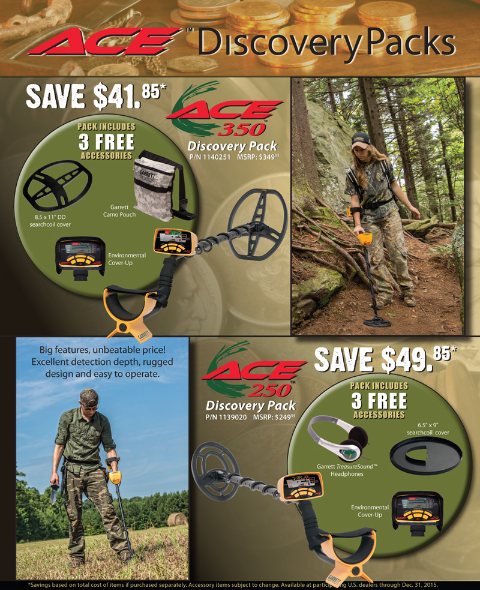
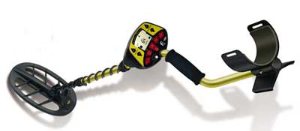
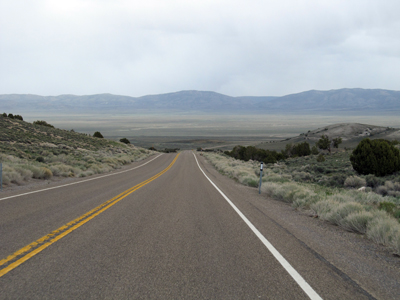 Road in America.” At the same time, AAA representatives warned travelers to avoid this empty 287-mile stretch unless they were “confident of their survival skills.” Much has changed in the last 30 years. The scenery is still wide open, there’s not a lot of traffic, but it’s far from lacking in amenities. This scenic corridor retraces the route of the Pony Express and Overland Stagecoach trails, connects you to plenty of recreational opportunities, and passes through five full-service communities. Eureka is one such stop along the route, and is one of the best-preserved 19th century mining towns in the state.
Road in America.” At the same time, AAA representatives warned travelers to avoid this empty 287-mile stretch unless they were “confident of their survival skills.” Much has changed in the last 30 years. The scenery is still wide open, there’s not a lot of traffic, but it’s far from lacking in amenities. This scenic corridor retraces the route of the Pony Express and Overland Stagecoach trails, connects you to plenty of recreational opportunities, and passes through five full-service communities. Eureka is one such stop along the route, and is one of the best-preserved 19th century mining towns in the state. 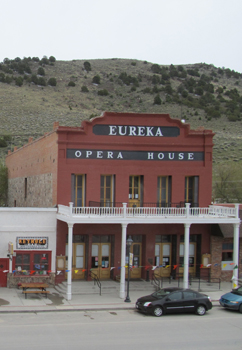
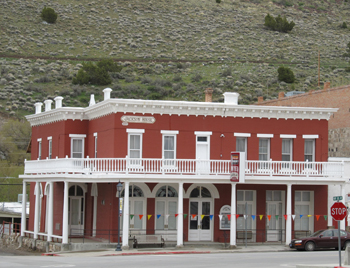
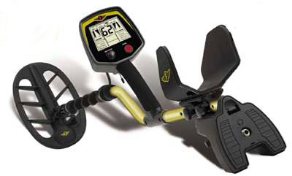
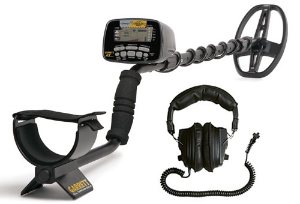
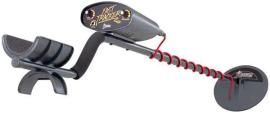
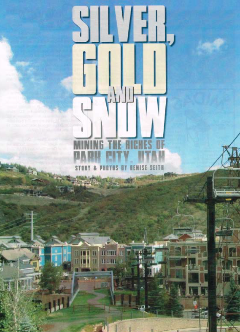

 were too far away from Barkerville! Today, more than 100 historic structures are still standing on the spots that they were built; many are active businesses. For the price of admission, this period frontier town offers daily activities and special events during the summer— guided town tours, blacksmithing demonstrations, story-telling by costumed interpreters, living history presentations— as well as shopping, dining, gold panning, and much more.
were too far away from Barkerville! Today, more than 100 historic structures are still standing on the spots that they were built; many are active businesses. For the price of admission, this period frontier town offers daily activities and special events during the summer— guided town tours, blacksmithing demonstrations, story-telling by costumed interpreters, living history presentations— as well as shopping, dining, gold panning, and much more. 
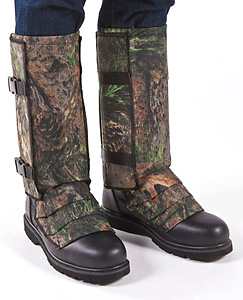
 If you've not yet attended a GPAA (Gold Prospectors Association of America) Gold & Treasure Show, the coming months provide an opportunity to rub elbows with some of the best prospectors and manufacturers in the business! Browse the show floor to find the latest and greatest gold mining and metal detecting equipment, see product demos, attend free seminars, ask questions of the pros, and enter to win door prizes. Weekend shows run 10 am - 4 pm. Presale admission is $5 by registering online or $10 at the door.
If you've not yet attended a GPAA (Gold Prospectors Association of America) Gold & Treasure Show, the coming months provide an opportunity to rub elbows with some of the best prospectors and manufacturers in the business! Browse the show floor to find the latest and greatest gold mining and metal detecting equipment, see product demos, attend free seminars, ask questions of the pros, and enter to win door prizes. Weekend shows run 10 am - 4 pm. Presale admission is $5 by registering online or $10 at the door.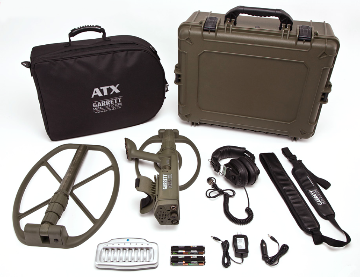
 my wrist, which gave it a perfect fit and feel, and allowed me to work all of the control buttons easily with my thumb. I pushed the unit out in front of me a bit and turned on the power switch, which is located on the back of the unit. The Garrett ATX Deepseeker Metal Detector goes through its startup and self-diagnostic test. Every light on the control pad comes on and unit emits several different sounds before settling into a comfortable, but high, threshold. This is not a turn-on-and-go detector. Either read the entire owners manual before you go out hunting, or at least read the first two pages of the manual— page 1 is the Quick Start Guide and an explanation of how to access the functions of the ATX quickly, and page 2 shows you where to find more information concerning those functions.
my wrist, which gave it a perfect fit and feel, and allowed me to work all of the control buttons easily with my thumb. I pushed the unit out in front of me a bit and turned on the power switch, which is located on the back of the unit. The Garrett ATX Deepseeker Metal Detector goes through its startup and self-diagnostic test. Every light on the control pad comes on and unit emits several different sounds before settling into a comfortable, but high, threshold. This is not a turn-on-and-go detector. Either read the entire owners manual before you go out hunting, or at least read the first two pages of the manual— page 1 is the Quick Start Guide and an explanation of how to access the functions of the ATX quickly, and page 2 shows you where to find more information concerning those functions.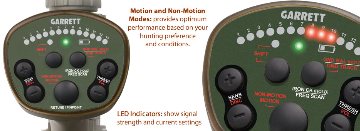 There are 5 major functions that are completely user-adjustable: Mode, Sensitivity, Threshold, Volume, and Ground Balance. Are functions are easy to adjust with a basic understanding of the ATX and more tunable as you become more proficient. Secondary functions include iron check, tracking, discrimmination and frequency shifting, to name only a few.
There are 5 major functions that are completely user-adjustable: Mode, Sensitivity, Threshold, Volume, and Ground Balance. Are functions are easy to adjust with a basic understanding of the ATX and more tunable as you become more proficient. Secondary functions include iron check, tracking, discrimmination and frequency shifting, to name only a few.